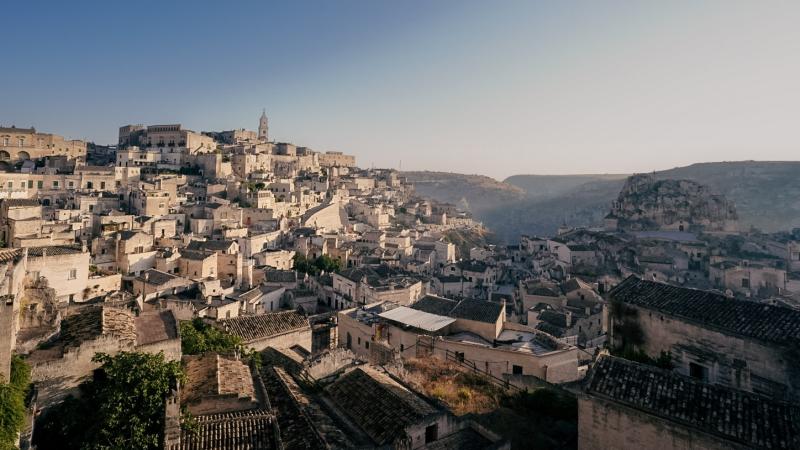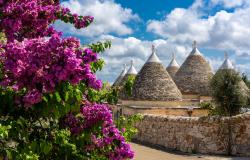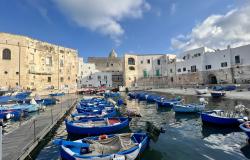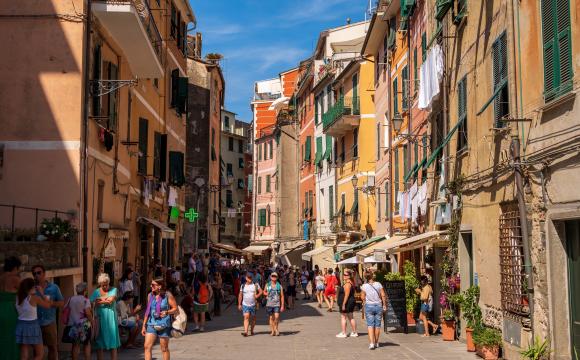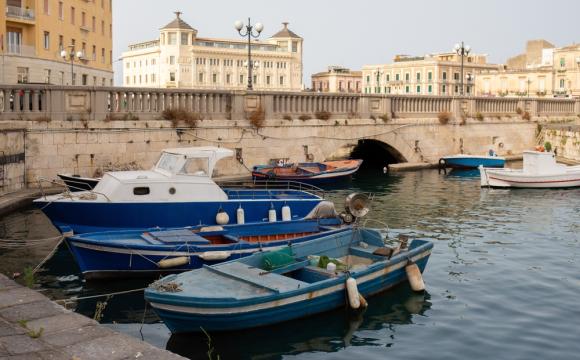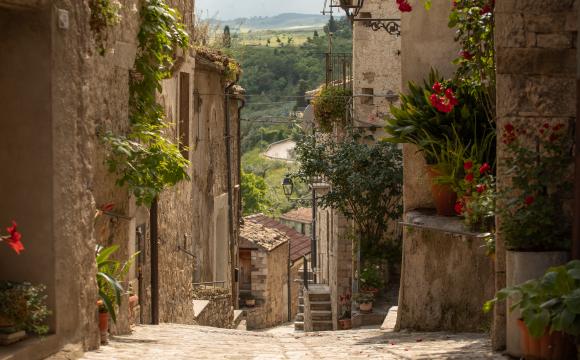Editor’s note: This exploration of the majestic Sassi di Matera offers a special preview of what you'll find in the full Basilicata issue of Bellissimo, our digital magazine that all Premium Members receive quarterly.
The article appears below as it originally ran.
I’m standing inside a cave where the walls hold black and white photographs of the family who once lived here. In one, the children are lined up in front of a large bed; in another, there’s a donkey in the kitchen. Furniture and domestic props laid carefully around me recreate the home as it once looked, complete with plastic animals to represent how families lived side by side with their livestock.
This is Casa Grotta Narrante, a cavernous house-museum in Matera that remembers a time when mortality rates were high and fires frequently tore through town. It evokes life as it probably felt back in 1950, when the now-popular destination was dubbed “the shame of Italy” by a visiting politician.
Today, scenes amid the Sassi di Matera — two rock-carved districts made up of world-famous, UNESCO-inscribed cave dwellings — couldn’t be more different than the ones that inspired that comment. The converted dwelling where I’m standing is steps away from the city’s first Michelin-star restaurant; nearby, throngs of tourists enjoy the plush beds of luxury hotels that decorate the insides of the ancient caves.
This is a place where many pasts exist simultaneously, and where contemporary life is full of contradictions. But to understand how Matera arrived at its shining present, you need to go back to the very beginning.
Ancient foundations
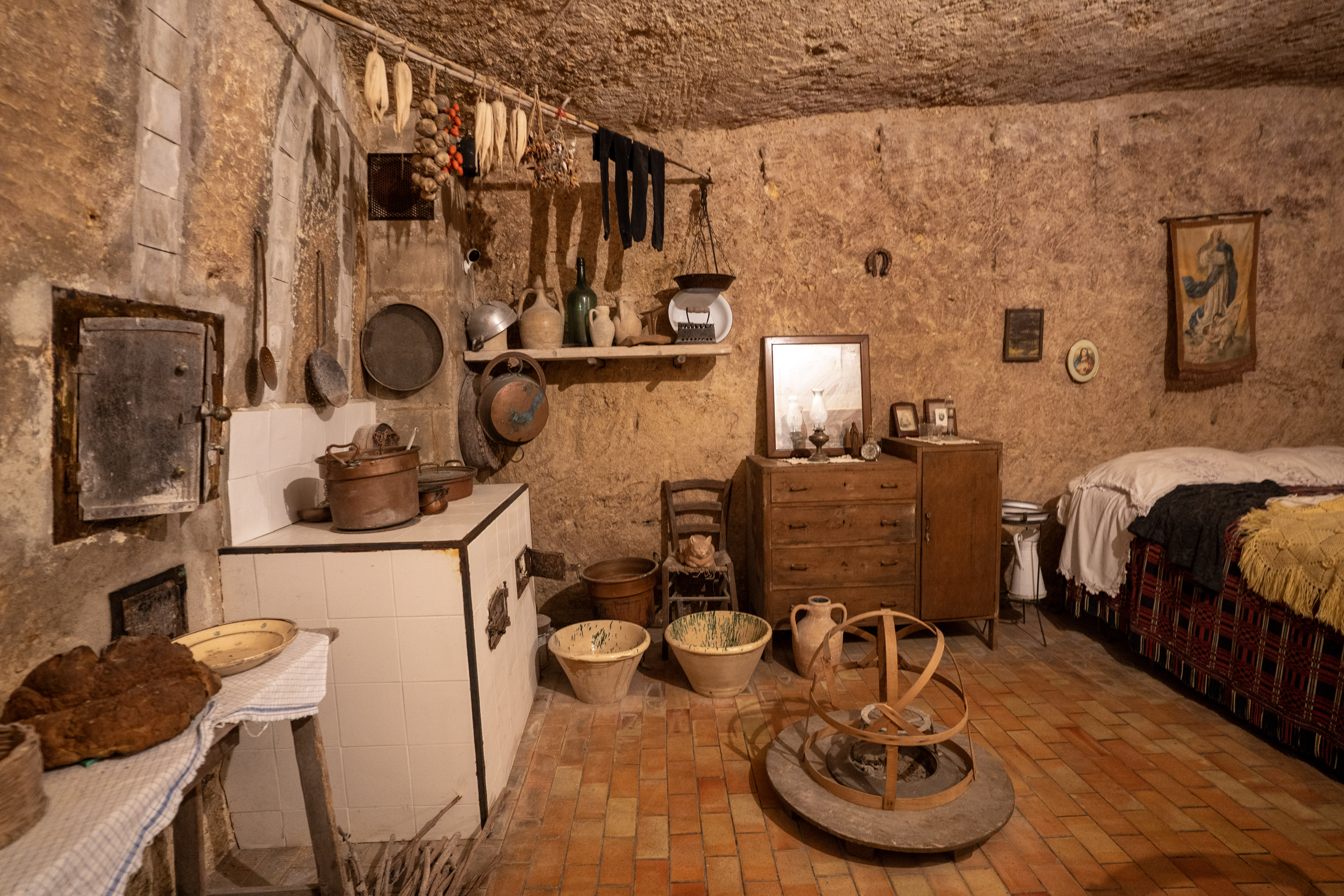
With evidence of human settlement in the Sassi and surrounding valley dating back to nearly 10,000 years ago, Matera is among the oldest cities in Europe. The word Sassi refers to the two historic districts embedded into the landscape above the Gravina River. It comes from the Latin word for “stone” or “rocky hill” but the area doesn’t just predate its name — it’s older than the invention of writing itself.
Since the Paleolithic Era, when human beings were beginning to use stone tools and leave their marks on cave walls, there have been people living in Matera. Looking across the steep river valley from the Via Madonna at the base of the Sassi, you can see the dark eyes of a few small caves embedded in the wild hillside. This is how the area might have looked to its prehistoric settlers, who typically traveled in small groups foraging and hunting as they went along before they began to carve their expanded shelters into the limestone.
It’s believed that Matera was a small enclave until the eighth century, as evidence of the city during the Greek ages and the Roman Empire is sparse. In the Middle Ages, the population grew and homes were built closer together. The caves that once provided shelter for the city’s prehistoric founders were delegated for storage and other purposes, while houses were constructed on the leveled-out avenues. For centuries, the stony hillside continued to grow and adapt, evolving with its new inhabitants.
People continued the traditions of the ancient settlers by building hundreds of rupestrian churches carved right into the tufa, a soft variety of limestone. The most wondrous in the city skyline is the Santa Maria Idris, which sits on the natural stage of Mount Errone, a cliff that rises from the middle of the Sassi like the top tier of a wedding cake. You can spend a long day in the Sassi meandering through the ancient streets, in and out of small chapels like Sant’Antonio Abate where performers demonstrate the enigmatic sounds of the cupa-cupa, a traditional friction drum sometimes known as a putipu.
You’ll have the best view of the Sassi from one of the city’s terraces like Piazzetta Pascoli or the perch of the 13th-century Maria Santissima Basilica, where you can appreciate a small piece of the landscape that assembles itself like a thousand-piece puzzle made up out of sand-colored buildings, punctuated by windows and doorways that seem to cascade over the hillside like a rocky waterfall frozen in time.
Descending the steep staircases and between the rooftops is a completely different experience. Sure, you can try to follow the little blue dot on your smartphone, but the energy of the city will pull you deeper into the Sassi until you reach one of the main roads like Via Bruno Buossi lined with restaurants like Era Convivial, one of many that has transformed an old cave into a romantic dining room. Or, you might find yourself following the back wall of an old church building when you come across the cocktail bar Zipa Cafè — a literal hole in the wall — which offers a wonderful view of the valley blending into the cityscape.
Today’s Matera is a livable archeological treasure, a destination where you won’t just lose track of where you are — you might forget what century it is. Still, a soft bed and indoor plumbing await you in your rough-hewn accommodations, and it’s easy to forget that life in the Sassi was not always comfortable and picturesque.
Rags to riches
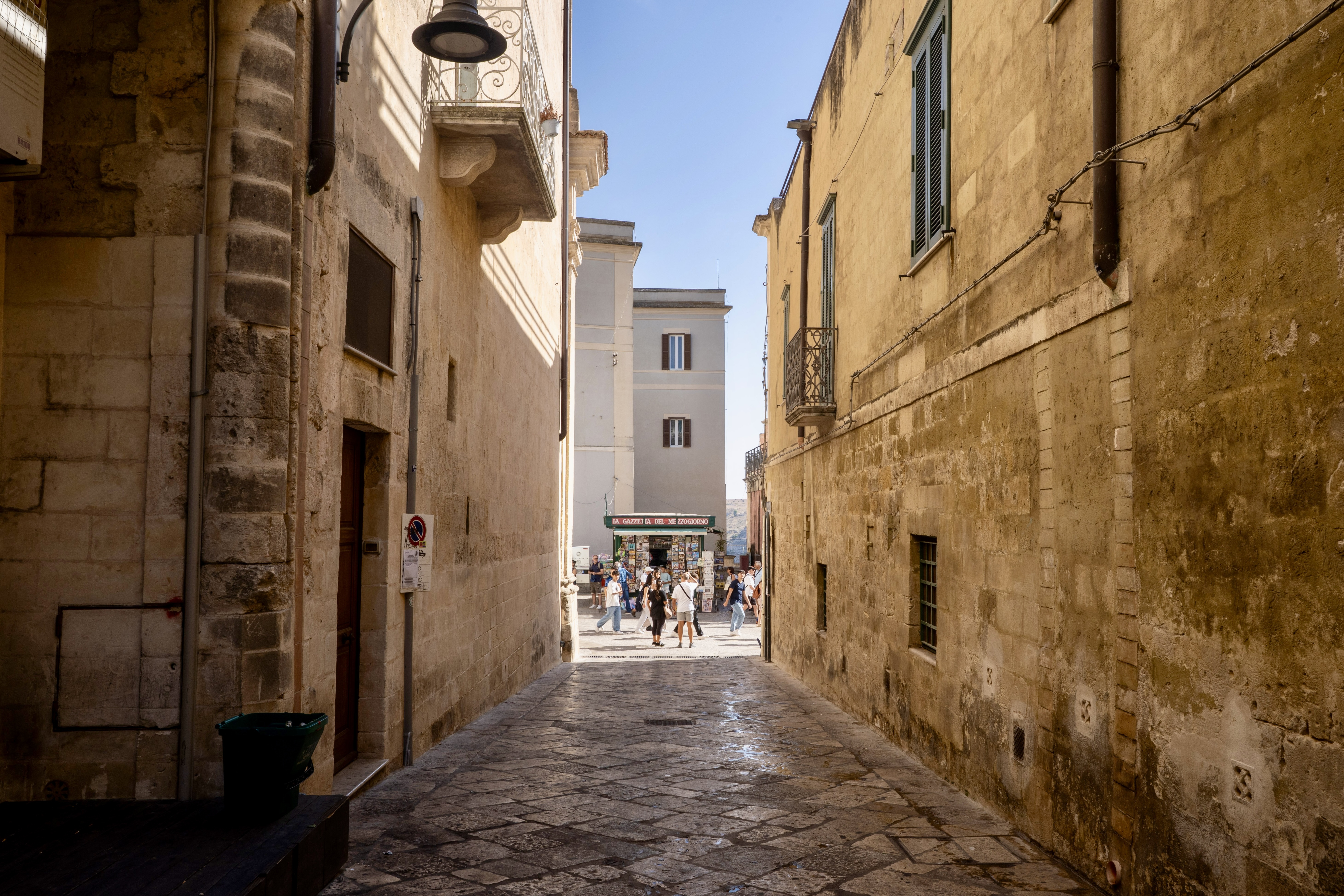
Matera’s poverty was first called to national attention following World War II when the writer Carlo Levi visited and called it the “capital of peasants” in his memoir Christ Stopped at Eboli, writing, “Anyone who sees the Sassi di Matera cannot help but be struck by its expressive and mournful beauty.” This inspired many politicians to find their way south and visit the city for themselves, including Prime Minister Alcide de Gasperi, who famously gave Matera the unfortunate moniker “the shame of Italy.”
De Gasperi was shocked by the abject conditions of poverty in the Sassi, where the local population was frequently plagued by diseases like malaria. Within two years of his visit, the people living there were relocated and moved into newly built social housing districts. The ancient city, which had been inhabited for thousands of years, was emptied and closed. The people of Matera continued to live above it in the modern town, but the Sassi, even with all its history and the former sanctity of the rock-carved churches, became an instant ghost town.
In 1993, UNESCO recognized the value of the Sassi when it was declared a World Heritage Site, a distinction that paved the way for Matera to be named European Capital of Culture in 2019 — the same year filming of the James Bond movie No Time to Die began amid the landscape. Since then, Matera’s star has been on the rise, but it hasn’t come without complications.
Sustainability and a hope for the future
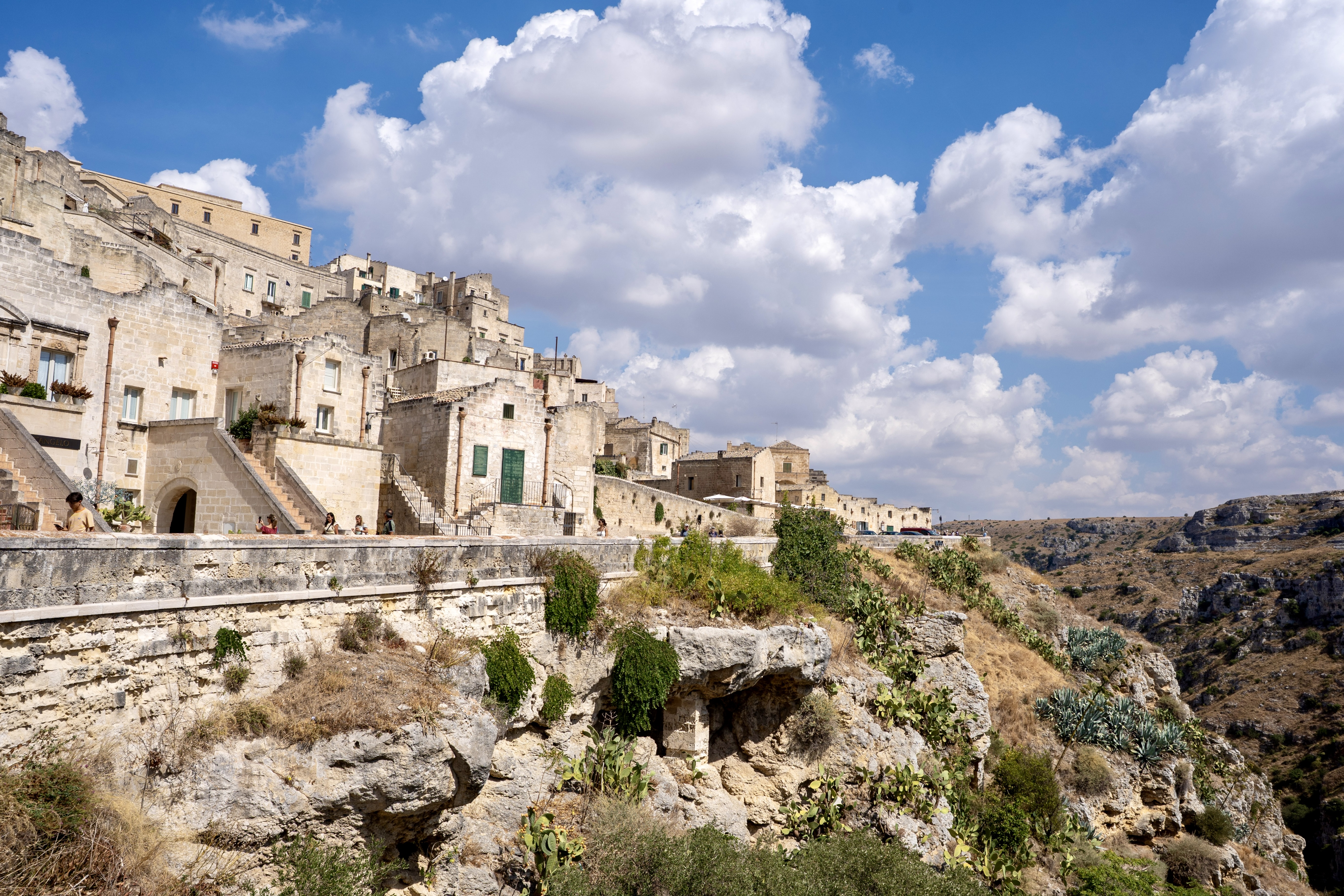
After large projects were undertaken to ensure the structural integrity of buildings in the Sassi, many people began to invest in its tourism potential, such as Rosanna Gaudiano, owner of Palazzo del Duca, a four-star boutique hotel.
“Fifteen years ago in the Sassi there were just five hotels,” Gaudiano tells me of the beginning of Matera’s transformation. “I feel the responsibility to spread this heritage and to not leave it abandoned, but to do something to give value to our heritage.”
However, overtourism has been a concern since the turning point of the Sassi’s transformation. UNESCO even called out in its initial evaluation that it “should be controlled with a visitor management plans to avoid the development which has ruined the ambiance of Alberobello [in Puglia] and its unique trulli.”
“We don’t want to create a tourism based on quantity, but quality,” Gaudiano explains and tells me that overtourism has been kept at bay thanks to Matera’s somewhat remote location 40 kilometers (25 miles) from the sea. “You don’t arrive in Matera casually; you have to choose it.”
Despite this distance, Matera’s newfound popularity has put it on the map of day trippers. “If we have a problem of overtourism, it is connected with the bus that arrives just for a day. They come, they park, walk in Sassi, take some photos, eat a sandwich and go back,” she explains, “So we have to preserve and try to not build our tourism on quantity but focus on small numbers of people who stay in Matera more than one night — people who want to know more about our culture and our story.”
At this point, I tell Gaudiano about my connection to the region, how I found my great-grandfather’s hometown just 30 minutes from Matera, and how ecstatic I was to discover that Basilicata and Matera were not only beautiful to visit, but had a surprisingly profound history.
“You feel it,” she agrees. “It’s impossible that Matera doesn’t transfer something that remains on your body, so you feel this energy.” In the Sassi, she points out, not only can you sleep in a house where people slept a thousand years ago, but there are also people who lived there not so long ago. They receive a lot of passersby at the hotel who stop to point out that they lived in this house or knew someone who lived in that one.
“It would be very beautiful if we could not only create hotels in the Sassi but also bring people and families to live inside. It’s a way to create a more active community,” Gaudiano said. Today, the Sassi have been mostly designated for tourism, with more than half being used for hotels, apartments, and restaurants, but she hopes that one day more of the community will move back into the Sassi, which is still about one-third abandoned.
Even with these challenges, Gaudiano points out, Matera is “one of the most ancient cities in the world where human presence has never stopped.” As she describes her vision for a Matera filled with main street fixtures of Italian community — the tabacchi, the bakery and so forth — Gaudiano paints a picture of a future Sassi that goes deeper than hotels and restaurants.
“We resisted a lot of wars, poverty and diseases, and we are still here,” Gaudiano says. Seventy-five years after De Gasperi’s visit and damaging remark, perhaps it’s time to re-christen Matera the “pride of Italy.”
Get more Basilicata with Bellissimo
To read the full Basilicata issue of Bellissimo, head to our online shop.
*Premium Members will need to log in to download. If you don't have Premium, you can sign up here. Single issues of Bellissimo are also available for purchase.
